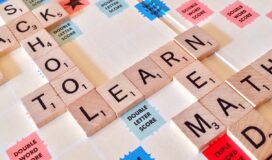January is a perfect opportunity to create a 30-day plan to start learning a foreign language in 2025. The “new year, better me” mindset gives you a clean slate to create intentional habits for the future.
People are usually more motivated to build habits during life transitions or milestone moments such as the beginning of the year. Starting your language learning journey early on aligns with this natural sense of renewal and optimism. Make 2025 the year you finally commit to mastering a foreign language!
Why You Need a Plan to Build a Language Learning Habit

Whether you’re starting to learn a foreign language or looking to improve your current language skills, having a plan is crucial. Here’s why:
-
Structure Leads to Consistency:
Learning a language isn’t a one-time effort; it’s about studying and practicing regularly. A plan will help you stay consistent, which is the foundation of habit-building. -
Motivation Fades Without Direction:
It’s easy to feel excited initially but lose momentum after a week or two. A clear roadmap will keep you focused and motivated. -
Trackable Progress:
A structured plan allows you to measure improvement, celebrate small wins, and adjust strategies when necessary.
This is why, following a 30-day plan will create a strong habit of studying a language that can be sustained throughout 2025 and beyond.
How to Build Your 30-Day Plan to learn a foreign language in 2025
1. Before you start
Step 1: Define Your Why
First of all, every language-learning journey begins with a purpose. Take time to reflect on why you want to learn this language. It will build the foundation that will drive your commitment and keep you focused.
Here are some guiding questions to uncover your “why”:
- Travel:
Do you dream of ordering croissants in perfect French at a Parisian café? Perhaps you want to connect with locals in their native language and experience a culture beyond the tourist bubble. - Career Opportunities:
Is fluency in a foreign language a stepping stone to advancing your career? Whether you’re aiming for international roles, client relationships, or freelance opportunities, language skills can be a powerful asset. - Personal Growth:
Are you looking to challenge yourself, sharpen your cognitive skills, or build confidence by stepping out of your comfort zone? Learning a new language is a rewarding way to expand your horizons. - Family or Heritage:
Do you want to communicate with family members, honor your cultural roots, or rediscover a heritage language? This emotional connection can be a deeply motivating reason to learn. - Social Connection:
Are you inspired by the idea of meeting new friends, joining language exchange events, or connecting with a global community?
2. Planning
Step 2: Set SMART Goals
Secondly, once you’ve identified your “why,” the next step is to translate your motivation into actionable, achievable goals. This is where the SMART framework helps you define objectives. Indeed, SMART stands for Specific, Measurable, Achievable, Relevant, and Time-bound, and applying it to your language learning will ensure you stay on track and see steady progress.
- Specific:
Clearly define what you want to achieve. Instead of saying, “I want to learn Spanish,” aim for something like, “I will learn 20 new travel-related vocabulary words.” - Measurable:
Include metrics to track your progress. For example, “I will practice speaking for 10 minutes daily and memorize 5 new verbs per week.” - Achievable:
Set realistic goals based on your schedule and current skill level. If you’re busy, a 30-minute daily study session might be more feasible than an hour. - Relevant:
Focus on objectives that align with your overall purpose. If you’re learning French for travel, prioritize conversational phrases and cultural vocabulary rather than advanced grammar rules you won’t use right away. - Time-bound:
Set deadlines to create urgency and maintain focus. For instance, “I will complete 10 lessons on Duolingo by the end of the month.”
Example of a SMART Goal: Be able to hold a 5-minute conversation with a language partner or tutor by the end of the 30 days.
Step 3: Create a Routine That Fits Your Lifestyle

Building a new habit, like learning a language, requires a routine that aligns with your daily life. In fact, a well-designed routine helps you stay consistent without feeling overwhelmed. Multitask strategically by pairing language learning with routine activities
- Morning commutes for listening to podcasts.
- Lunch breaks for quick vocabulary reviews.
- Evenings for grammar practice or speaking exercises.
- Listen to music in your target language while exercising.
Consistency matters more than long, sporadic sessions. Spending 15–30 minutes a day on focused study is often more productive than setting aside long, infrequent sessions on the weekend.
3. Execution
Step 4: Choose the Right Resources
Additionally, learning a foreign language in 2025 should be efficient and enjoyable, it’s essential to equip yourself with the right tools. From traditional methods to cutting-edge AI-powered resources, having the right materials can transform your study sessions into productive and engaging experiences.
- Apps: Duolingo, Babbel, or Memrise for gamified learning.
- Notebooks or Journals: Record vocabulary, grammar notes, and personal reflections.
- Flashcards: Physical or digital, perfect for quick revisions.
- Podcasts: Tune in to beginner-friendly shows like Coffee Break Spanish.
- Videos or Movies: Immerse yourself with subtitles to learn naturally.
Hence, the right resources not only make studying more effective but also keep you motivated and engaged throughout your journey.
Step 5: Stay Motivated

Staying motivated is one of the biggest challenges in learning a new language. The key to overcoming this hurdle is keeping your journey creative, engaging, and rewarding. By incorporating a mix of fun activities, visual tools, and AI-driven platforms, you can turn language learning into something you look forward to every day.
- Create a vision board: Include travel photos, motivational quotes, and language goals.
- Join a community: Attend language meetups or online groups for interaction.
- Celebrate milestones: Treat yourself when you reach weekly or monthly goals.
3. Tracking
Step 6: Review and Adjust Weekly
Finally, building a language learning habit isn’t about perfection: it’s about consistent effort over time. A weekly review allows you to reflect, adapt, and ensure your routine aligns with your progress and lifestyle. By taking just a few minutes each week to evaluate what’s working and what isn’t, you can stay on track and make meaningful adjustments. At the end of each week:
- Reflect on what worked and what didn’t.
- Adjust your goals or routine to fit better into your schedule.
- Reward yourself for sticking to your plan.
A weekly review is your chance to recalibrate and stay aligned with your goals. Reflect, adjust, and reward yourself. These small steps create a sustainable learning habit
Conclusion
Therefore, a 30-day plan is the perfect way to start learning a foreign language in 2025. By starting the habit in January, you’ll create a foundation for success throughout the year. With SMART goals, a personalized routine, and the right resources, you can turn your language-learning dreams into reality.
Remember, language learning is a marathon, not a sprint. Consistent effort will always outweigh perfection.
Ready to start your 30-day language learning journey? Download our free habit tracker and join the challenge today!









